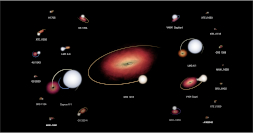 HEAPOW: Black Hole Roundup (2022 May 02)
HEAPOW: Black Hole Roundup (2022 May 02)
Happy Black Hole Week! This week NASA is celebrating the weird and wonderful world of black holes to help answer your questions about these mysterious objects, such as: "if nothing can escape from a black hole, how can we see them?"; "what would happen if I fell into a black hole?"; "what does a black hole look like?" And lots more! To get started, the image above is a frame of a wonderful new video featuring the confirmed black hole systems in our own Milky Way galaxy, and in our neighbor galaxy, the Large Magellanic Cloud. The video shows the variety of black hole binary systems in which the black hole produces high energy radiation by swallowing material off an unfortunate companion star. These types of systems, while extremely powerful, are relatively modest, housing black holes a few times more massive than our Sun. There are also the monster behemoths which have more mass than millions (or even billions) of suns which reside at the centers of galaxies, some of which pour out jets of charged particles and radiation for millions of light years into space. And on the other end of the scale, there may be teeny-tiny primordial black holes having masses less than that of a mosquito, that might have formed in the early stages of our Universe, and which may be evaporating now in a shower of sub-atomic particles of matter and anti-matter. But black holes might not produce any radiation at all: stealthy non-accreting and non-evaporating black holes might be only detectable by the way they warp spacetime when they pass in front of you, and so very difficult to detect. How close is the nearest such black hole? No one knows.
NASA Visualization Rounds Up the Best-Known Black Hole Systems
| << Previous HEAPOW | High Energy Astrophysics Picture of the Week | Next HEAPOW >> |